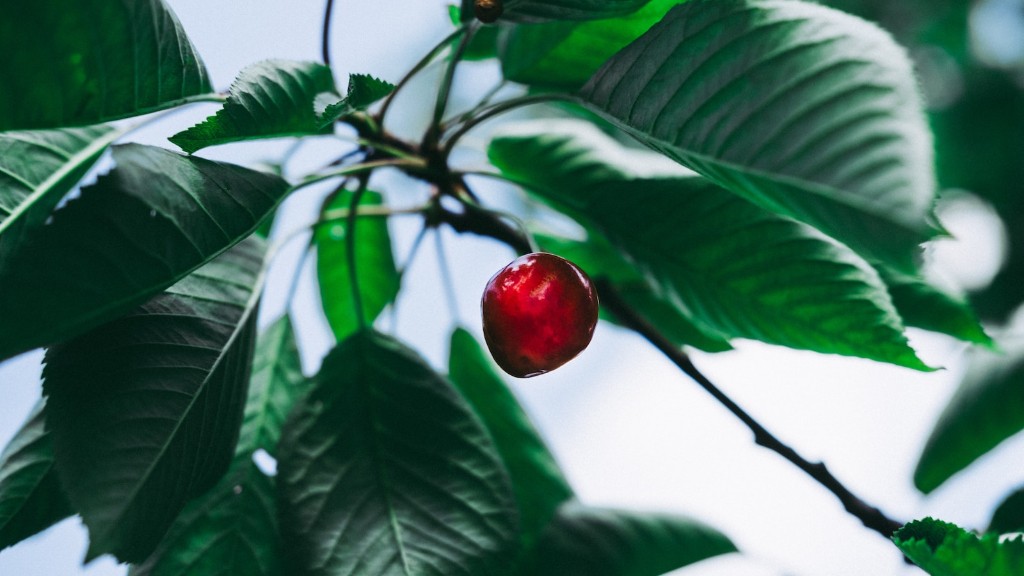Preparing for Planting
Before getting started on planting a cherry tree, it is important to consider the following factors. Firstly, it is important to have the correct soil conditions and a plot of land that will allow the cherry tree to grow and thrive. The plot should have well-draining soil and receive at least six hours of direct sunlight. Additionally, it is important to select the correct variety of tree for the region in which it will be planted. The Bing cherry tree in particular is hardy and low-maintenance, which makes it somewhat suitable for those who will not be able to devote a great deal of time to cultivating the tree.
Secondly, it is important to ensure that the cherry tree receives the right nutrients. Cherry trees require well-balanced fertilizer that is high in nitrogen, phosphorus, and potassium; this nutrient mixture will ensure that the cherry tree has the best health possible. Once the fertilizer has been applied to the land, it is important to prepare the soil ahead of planting. The ground needs to be tilled and broken up in order to ensure that the roots can take in moisture and nutrients efficiently.
What Materials are Needed
Thirdly, when it comes to planting a cherry tree, there are certain materials that need to be gathered in order for the task to be completed successfully. The first item that is needed is a shovel. A shovel with a wide blade is generally the best option for planting larger trees, such as cherry trees. Additionally, a bucket is necessary for carrying soil and watering the tree. A watering can can also be used for this purpose. The last key item needed is the sapling itself. When purchasing a sapling, it is important to look for a healthy specimen that does not have any visible bruises or diseases.
Planting the Cherry Tree
The fourth step to planting a cherry tree is to actually put the tree in the ground. Begin by creating a hole in the ground that is slightly larger than the root ball of the tree. Once the hole has been created, place the root ball into the hole and use the shovel to carefully fill it back up with the soil. When the hole is filled, it is important to tap the ground around the roots of the tree gently in order to ensure that all of the air pockets are released.
Next, it is important to water the ground and begin to cultivate the soil around the cherry tree. Make sure to till the ground at least six inches from the base of the tree and incorporate fertilizer into the surface. Lastly, it is important to form a basin around the base of the cherry tree. This will help retain water and discourage weeds from growing over the roots.
Maintaining and Pruning the Tree
Progressing forward, it is essential to understand how to properly maintain a cherry tree. The best way to keep the tree healthy is to water and fertilize it regularly. For cherry trees, it is advised to specifically wait until just before the growing season begins to fertilize, as the nutrients will help the tree to blossom and the fruits to mature. Additionally, it is important to pay attention to the soil conditions and make sure that the ground does not become overly dry or water-logged.
Pruning is also necessary for a cherry tree, as keeping growth in check will help ensure that the fruits remain plump and juicy. During the winter months, it is recommended to trim off any dead or weak branches in order to allow new and strong growth to come through in the spring.
Protection from Diseases and Pests
Protection from common diseases and pests is also important to the health of a cherry tree. Different diseases and pests will depend on the region, but the best way to protect a cherry tree is to maintain it well and ensure that it is not under too much stress. Additionally, it is important to be aware of common signs of distress, such as discoloration, wilting, and a lack of growth, and make sure to address any issues if they arise.
Other pests that can be commonly found on cherry trees include aphids and mealybugs. Both of these pests can be removed by spraying a combination of water, natural insecticides, and neem oil. It is important to note that it is best to take preventative measures against pests, as this will generally be most effective in controlling them.
Harvesting
Finally, the sixth step involved in planting a cherry tree is the harvesting of the fruits. When harvesting a cherry tree, it is important to wait until the fruit is fully ripe before picking. This will generally depend on the variety of cherry tree being used, but typically it is recommended to wait until the fruits are deep red or even beginning to turn black before picking them.
Once the fruit is harvested, it is important to ensure that it is stored properly. Cherries are best stored in an air-tight container and can be kept in a cool, dark area of the refrigerator in order to maintain the best flavor. Additionally, cherries can be frozen if they are not going to be used immediately.
Importance of Planting in a Sustainable Manner
When it comes to planting a cherry tree, it is important to make sure to do so in a sustainable manner. Sustainable tree planting practices help to minimize the environmental impacts that come with the task, while still ensuring that the tree is able to thrive. Sustainable practices include choosing a tree variety that is native to the area and understanding the proper water and nutrient requirements for the species. Additionally, it is important to avoid over-fertilizing the soil and, if possible, to avoid the use of chemical or synthetic fertilizers.
Preventing Soil Erosion
One way to keep a cherry tree growing healthily in a sustainable manner is to prevent soil erosion. This task can be accomplished by planting trees in the correct locations and keeping the soil in a healthy, balanced state. For instance, it is important to make sure that water is not running off the land, as this can cause nutrient-rich soil to be swept away. If necessary, it is recommended to create terraces or berms in order to ensure that this does not occur.
Additionally, it is important to look at the topography of the planting area in order to identify areas that may be prone to soil erosion. If these spots can be identified, they can be fortified with stones, mulch, or other materials in order to ensure that the soil remains in its natural, healthy state.
Protecting Against Wind Damage
The eighth step involved in planting a cherry tree in a sustainable manner is to protect the tree from wind damage. Cherry trees can suffer from damage due to strong winds, as this can cause branches and young growth to break off. In order to prevent this from happening, it is important to create a windbreak of trees around the cherry tree in question. This will help to protect it from the intense gusts of wind and keep it healthier for longer.
Additionally, it is wise to stake the cherry tree in order to help steady it and reduce the chance of the tree being damaged in winds. If a stake is being used, it is important to ensure that it is not too close to the tree, as this can cause unwanted stress.
Insect and Disease Management
The last step involved in planting a cherry tree in a sustainable manner is to be aware of common pests and diseases. Different regions have different pests and diseases that can affect a cherry tree, so it is important to be aware of the common issues in the area in order to treat them quickly. Additionally, it is important to focus on preventative measures in order to keep the cherry tree as healthy as possible. This can include introducing beneficial insects to the land and using natural insecticides, such as neem oil, in order to control any potential problems.
By following these steps when planting a cherry tree, it is possible to ensure that the tree is able to thrive and produce fruit in a sustainable manner. With the right planning and maintenance, a cherry tree can be a great addition to any garden or landscape.

